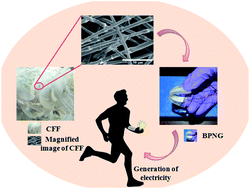Chicken feather fiber-based bio-piezoelectric energy harvester: an efficient green energy source for flexible electronics†
Abstract
The great demands of wearable electronics and self-powered biomedical devices have triggered the search for efficient, biocompatible, flexible energy harvesters. However, it is still challenging to develop such advanced energy harvesters by directly using nature-driven biomaterials. Here, we report the fabrication of a biocompatible, flexible bio-piezoelectric energy harvester (BPEH) by directly using chicken feather fiber (CFF). CFF is a readily available bio-waste, with excellent mechanical properties and surface to weight ratio, thanks to its specific filamentous structure. A light-weight (∼1 g) cell of BPEH demonstrates excellent piezoelectric output voltage (10 V), power density (6 μW cm−2) and current density (1.8 mA cm−2) under periodic biomechanical pressure (0.13–0.31 MPa) exerted by finger imparting. The excellent output performance of BPEH is attributed to the keratin-enriched CFF. The constituent hydrogen bonds of the keratin structure cause the piezoelectric behavior of CFF (d33 ∼ 1.6–2.1 pC N−1), whereas the disulfide bonds of CFF provide superior mechanical strength. The real-life applications of efficient BPEH were investigated by charging capacitors, illuminating LEDs and monitoring the pulse rate of a human. The biocompatibility of BPEH was confirmed using human adult dermal fibroblast cells. Hence, BPEH can be readily used for driving wearable electronics, bio-implantable and healthcare monitoring devices.



 Please wait while we load your content...
Please wait while we load your content...